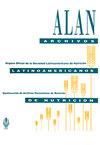Ultra-processed foods in institutional food services: what are diners eating?
IF 0.3
4区 医学
Q4 NUTRITION & DIETETICS
引用次数: 0
Abstract
Introduction. Frequent use of ultra-processed foods (UPF) leads to poor health outcomes, and the population must avoid their consumption. Objective. To assess the occurrence of ultra-processed foods (UPFs) in culinary lunch menus from various institutional food services. Materials and methods. Over one month, the five institutional food services analyzed served 1,128 culinary preparations; and a total of 3,863 ingredients were classified according to the extent and purpose of processing using the NOVA classification system. Associations between the occurrence of UPFs and the type, size, and management of food service establishments were analyzed. Five institutional food services in three municipalities (Bauru, Limeira, and Campinas), Brazil. Results. We found 8.4 % up to 12.6 % UPF ingredients used in culinary preparations. The highest frequency of UPFs was associated with private cafeterias (p = 0.002). Most UPFs were part of the recipe or the main ingredient in protein dishes and desserts (p < 0.05) and in university and hospital food services, respectively. UPF use was associated with food service size and type of management (p ≤ 0.003) and was more prevalent in protein dishes (p = 0.003) and large-size institutional food services (28.8 %). Self-managed units (p = 0.03) also use high amounts of UPFs in protein dishes (20.3 %). Conclusions. The presence of UPF rounded 10%; the validity of this value needs further studies. There are no comparative data in the scientific literature regarding the use of these ingredients in institutional food service culinary preparations. Therefore, it is necessary to stimulate reflection to promote healthy food habits and adequate nutrition for diners.机构食品服务中的超加工食品:食客在吃什么?
介绍频繁使用超加工食品会导致健康状况不佳,人们必须避免食用。客观的评估各种机构食品服务的烹饪午餐菜单中超加工食品的出现情况。材料和方法。在一个多月的时间里,分析的五家机构食品服务机构提供了1128份烹饪准备;使用NOVA分类系统根据加工的程度和目的对总共3863种成分进行了分类。分析了UPF的发生与餐饮服务机构的类型、规模和管理之间的关系。巴西三个市镇(包鲁、利梅拉和坎皮纳斯)的五家机构食品服务机构。后果我们发现8.4%至12.6%的UPF成分用于烹饪准备。UPF发生频率最高的是私人自助餐厅(p=0.002)。大多数UPF分别是蛋白质菜肴和甜点(p<0.05)以及大学和医院食品服务的配方或主要成分。UPF的使用与食品服务规模和管理类型有关(p≤0.003),在蛋白菜肴(p=0.003)和大型机构食品服务(28.8%)中更为普遍。自我管理单位(p=0.03)在蛋白质培养皿中也使用大量UPF(20.3%)。结论。UPF的存在取整了10%;这一价值观的有效性有待进一步研究。科学文献中没有关于在机构食品服务烹饪准备中使用这些成分的比较数据。因此,有必要激发反思,促进食客的健康饮食习惯和充足营养。
本文章由计算机程序翻译,如有差异,请以英文原文为准。
求助全文
约1分钟内获得全文
求助全文
来源期刊
CiteScore
0.50
自引率
0.00%
发文量
31
期刊介绍:
Archivos Latinoamericanos de Nutrición (ALAN) is the official publication of the Sociedad Latinoamericana de Nutición (SLAN), for the dissemination of knowledge in the fields of food and nutrition, principally throughout the American Hemisphere. Articles in Spanish, English, Portuguese and French are accepted, both from the Society members and from nonmembers, in the following categories: 1. General articles (critical scientific reviews); 2. Research articles (originals); 3. Papers in applied nutrition (analytical results from intervention programs and discussion of reconmendations of practical application), and 4. Letters to Editor (short comments of general interest or about scientific facts and results previously published in Archives).

 求助内容:
求助内容: 应助结果提醒方式:
应助结果提醒方式:


